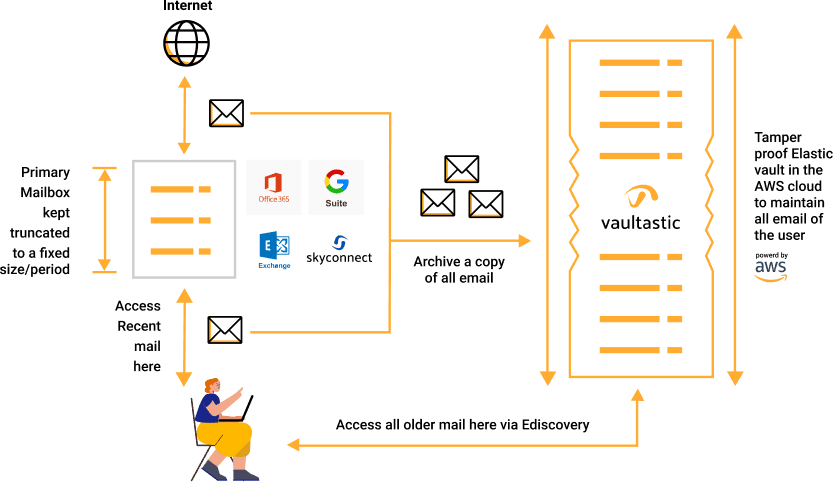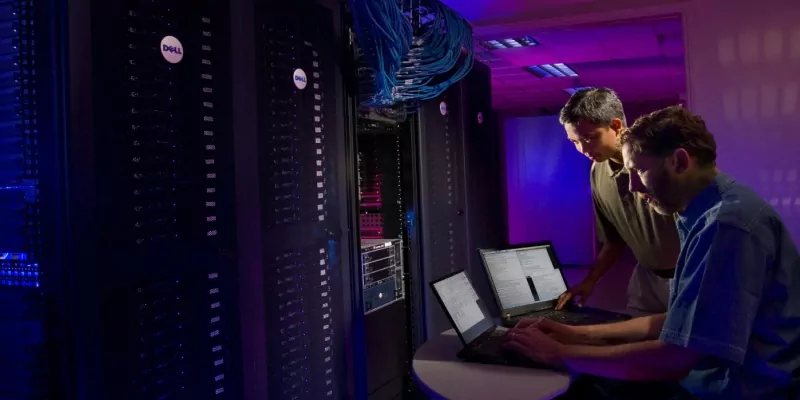Why is long-term data retention such a big challenge?
Here are some global statistics about the humongous growth of email data:
- 80% of all global data will be unstructured by 2022 (Gartner).
- 70% of this unstructured data is email (Most global estimates), and
- 60% of emails carry business-critical data (IDC).
In actual numbers,
- an average user’s mailbox grows by 4GB every year, and
- each business user sends and receives a total of 160 emails a day (as of 2022. Source: Earthweb)
This is BIG data and a big problem too for any long-term data retention strategy.
Managing this high Volume, Velocity, and Variety of emails is challenging for an organization.
Traditional responses to growing/filling mailboxes can be unproductive
Traditional email preservation methods create fragmentation and make it challenging to locate information on-demand besides the management headaches and escalating costs.
Most cloud email services provide sufficiently large mailboxes suitable to start with but soon fill up.
Besides being Risky, Costly, and Clunky
Besides the loss of user productivity, there are other business impacts from email storage getting full:
Performance Degradation
Growing mailboxes may overload the email apps and slow down their performance.
Cost Implications
Mailboxes approaching their limits need more resources, either as expensive plan upgrades or the purchase of additional storage.
Data & Compliance Risks
To keep within quota limits, users typically download and delete data to create space in their mailboxes, increasing risks for the organization in maintaining a complete record of exchanging information over email.
Hard to Locate information
Storage tiering is a scalable solution for long term email data retention

Step 1: Capture a copy of all new emails in Vaultastic
Configure journaling from your mail system to ensure a copy of every email sent/received is automatically captured in tamper-proof vaults on Vaultastic. Learn more about how to configure journaling.
Step 2: Migrate historical data from live mailboxes to Vaultastic.
Migrate old data from the users’ mailboxes to Vaultastic using the Legacyflo app. Learn more.
Step 3: Reduce Email Storage using a retention/truncation policy on the live mailbox
Now that a copy of all old and new emails is available in Vaultastic, you can now apply a retention policy on the live mailbox to keep it small. E.g., delete mail older than six months to restrict the growth of the live mailboxes.
Remember, it costs more to store the email data on live mailboxes than in an archival store like Vaultastic, which works hard to optimize storage costs across the entire data life cycle.
Step 4: Access on demand
The users (and supervisors) can now access recent emails via the live mailboxes and all older emails from the Vaultastic Ediscovery console, quickly locating specific pieces of information and documents buried anywhere in the email store. Learn more about the ediscovery app.
Step 5: Further optimize costs by moving infrequently used and aging data to the Open Store
Leverage one more level of storage tiering with Vaultastic’s two stores, viz. the active store for frequently used recent email that is search ready and the Open Store for infrequently used aging data.
Benefits of storage tiering go beyond long-term data retention




Conclusion – storage tiering enables long-term email data retention at 60% reduced costs
Using the storage tiering strategy, you benefit from a lean live mailbox, which ensures a consistent mail system performance and prevents cost escalation on your mail solution regarding plan upgrades or additional storage.
In addition, the central, immutable repository, now created on Vaultastic, minimizes data-related risks and makes it easy to discover data of any period on-demand.
By including the storage tiering internal to Vaultastic with your strategy, you can further compress costs to achieve up to 60% cost optimization for long-term data retention of email.
Resources:










